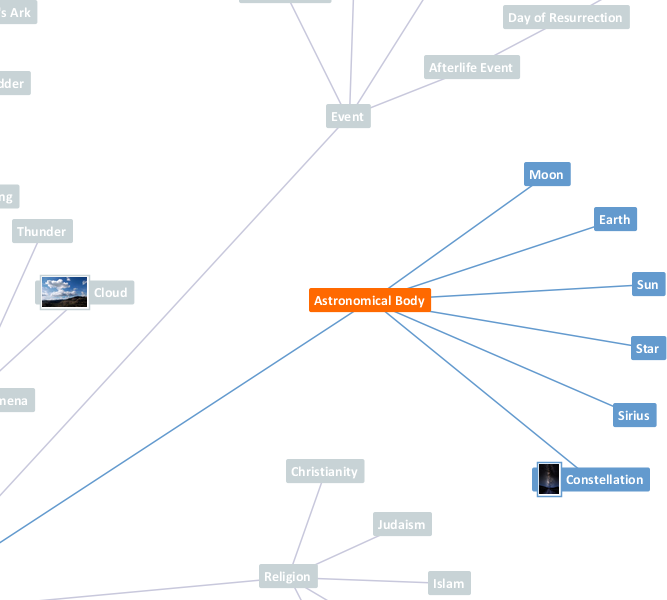The Quranic Ontology uses knowledge representation to define the key concepts
in the Quran, and shows the relationships between these concepts using predicate logic. The fundamental concepts in the ontology are based on
the knowledge contained in traditional sources of Quranic analysis, including the hadīth
of the prophet muhammad  , and the tafsīr (Quranic exegesis) of ibn kathīr.
Named entities in verses, such as the names of historic people and places mentioned in the Quran, are linked to concepts in the ontology
as part of named entity tagging. The diagram below shows a visual representation of the ontology. The graph is a network of
300 linked concepts with 350 relations.
, and the tafsīr (Quranic exegesis) of ibn kathīr.
Named entities in verses, such as the names of historic people and places mentioned in the Quran, are linked to concepts in the ontology
as part of named entity tagging. The diagram below shows a visual representation of the ontology. The graph is a network of
300 linked concepts with 350 relations.
Fig 1. The Quranic Ontology. Each node in the graph represents a unique concept in the Quran.
As well as listing the major concepts in the Quran, the ontology also defines a set of semantic relations between these concepts. The most important relation is the set membership relation "instance" in which one concept is defined to be an instance or individual member of another group. For example the relation "Satan is a jinn" in the ontology would represent the knowledge contained in the Quran that the individual known as Satan belongs to the set of sentient creations named the jinn. Other concepts in the ontology and grouped into logical categories, according to the properties that they share. For example, the Sun, Earth and Moon are classified under "Astronomical Body":

Fig 2. A closer look at the ontology, showing the semantic relations between concepts.
Pronoun Resolution
In the Quranic Arabic Corpus, morphological word segments are linked to concepts in the ontology in order to resolve pronouns. An example can be found in the first verse at the start of chapter 97:
Sahih International: Indeed, We sent the Qur'an down during the Night of Decree.
Although the translation correctly reads "We sent down the Quran", the original Arabic text uses pronouns and does not explicitly mention the Quran in this verse. A more literal translation would be "We sent it down". Through traditional Quranic exegesis (tafsīr ibn kathīr) we know that this verse refers to Allah revealing the Quran during the Night of Decree.
| Translation | Arabic word | Syntax and morphology |
| (97:1:1) innā Indeed, We | ACC – accusative particle PRON – 1st person plural object pronoun → Allah حرف نصب و«نا» ضمير متصل في محل نصب اسم «ان» | |
| (97:1:2) anzalnāhu revealed it | V – 1st person plural (form IV) perfect verb PRON – subject pronoun → Allah PRON – 3rd person masculine singular object pronoun → Quran فعل ماض و«نا» ضمير متصل في محل رفع فاعل والهاء ضمير متصل في محل نصب مفعول به |
Fig 3. Pronoun resolution for verse (97:1)
Figure 3 above shows morphological annotation for the first two words of verse (97:1). This annotation includes pronoun resolution where attached pronoun clitics are hyperlinked to concepts in the Quranic ontology (Allah and the Quran):
PRON – subject pronoun → Allah
PRON – 3rd person masculine singular object pronoun → Quran
Named Entity Tagging
As well as pronouns, named entities found in the Arabic text of the Quran are also linked to concepts in the ontology. Figure 4
below shows the remaining morphological annotation for verse (97:1). This verse includes a named
entity known as the Night of Decree (also translated as the Night of Power). This is the night in the month of Ramadan
in which the Quran was first revealed to the prophet Muhammad  .
.
| Translation | Arabic word | Syntax and morphology |
| (97:1:3) fī in | P – preposition حرف جر | |
| (97:1:4) laylati (the) Night | N – genitive feminine noun → Night of Decree اسم مجرور | |
| (97:1:5) l-qadri (of) Power. |  | N – genitive masculine noun اسم مجرور |
Fig 4. A named entity in verse (97:1)
A named entity may span multiple words, and the full length of the span is recorded during named entity annotation. The website displays the syntactic head word in the span as being linked to the corresponding concept in the ontology, as shown in (97:1:4) above. In this particular case, the head word is the first word in the possessive construction of iḍāfa (إضافَة):
N – genitive feminine noun → Night of Decree
See Also
- Concept - the root entity in the ontology
- Ontology (information science) - Wikipedia article discussing ontologies and knowledge representation




